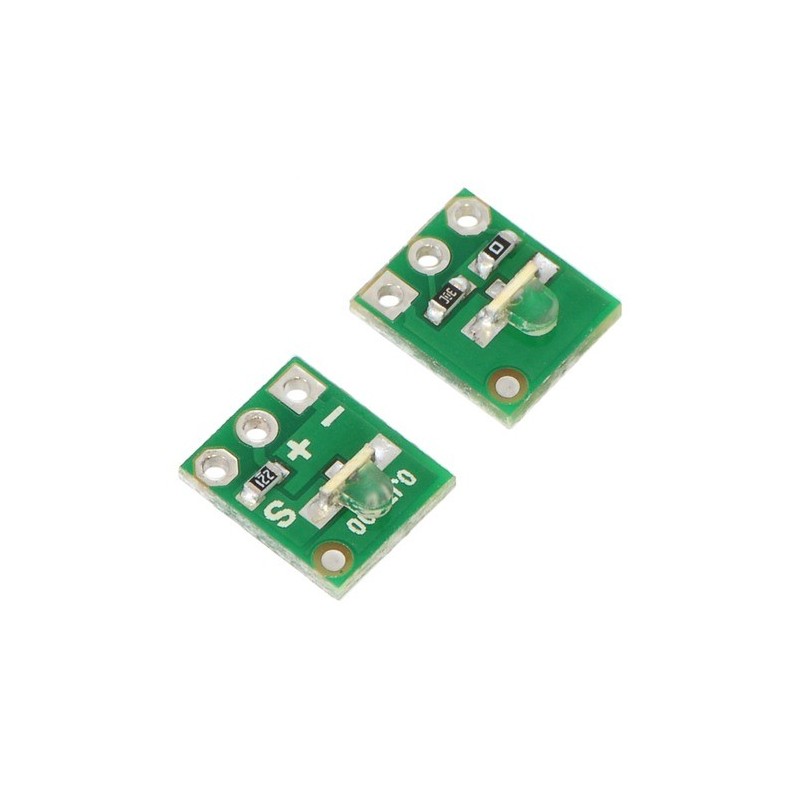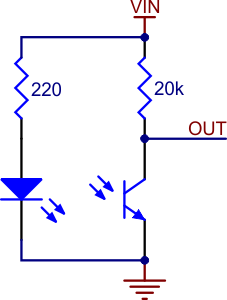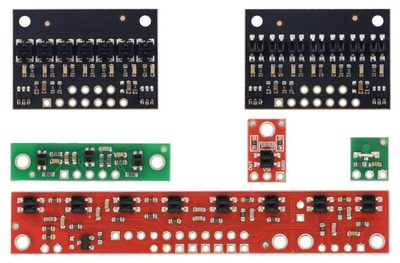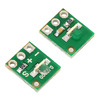



16,32 zł Netto

darmowa wysyłka na terenie Polski dla wszystkich zamówień powyżej 500 PLN

Jeśli Twoja wpłata zostanie zaksięgowana na naszym koncie do godz. 11:00

Każdy konsument może zwrócić zakupiony towar w ciągu 14 dni bez zbędnych pytań
The QTR-L-1A reflectance sensor incorporates a right-angle infrared LED and a right-angle phototransistor in an inexpensive, tiny 0.35" A— 0.3" module that can be mounted almost anywhere and is great for edge detection and line following. The reflectance measurement is output as an analog voltage. This sensor is sold in packs of two units.
Note: The QTR-L-1A reflectance sensor requires an analog input to take readings. The similar QTR-L-1RC reflectance sensor is available with a digital I/O-compatible output.
 |
The Pololu QTR-L-1A reflectance sensor carries a right-angle infrared LED and a right-angle phototransistor, both pointing toward the front edge of the board. The phototransistor is connected to a pull-up resistor to form a voltage divider that produces an analog voltage output between 0 V and VIN (which is typically 5 V) as a function of the reflected IR. Lower output voltage is an indication of greater reflection.
The LED current-limiting resistor is set to deliver approximately 17 mA to the LED when VIN is 5 V. The current requirement can be met by some microcontroller I/O lines, allowing the sensor to be powered up and down through an I/O line to conserve power.
This sensor was designed to be used with the board perpendicular to the surface being sensed, and narrow-angle lenses built into the infrared LED and phototransistor packages allow it to be effective to a range of about 1" (25 mm). Because of its small size, multiple units can easily be arranged to fit various applications such as line sensing and proximity/edge detection. The QTR-L-1A is sold in packs of two units.
For a similar sensor that can be used with the board parallel to the surface, but with shorter range, please see the QTR-1A reflectance sensor. We also offer arrays of three and eight sensors: the QTR-3A reflectance sensor array and the QTR-8A reflectance sensor array.
 |
| QTR sensor size comparison. Clockwise from top left: QTR-3RC, QTR-1RC, QTR-L-1RC, QTR-8RC. |
|---|
 |
There are several ways you can interface with the QTR-L-1A output:
This last method will work if you are able to get high reflectance from your white surface (so that there is a large output voltage difference over black and white surfaces), but will probably fail if you have a lower-reflectance signal profile. The following table shows some typical output voltages from the sensor over different surfaces and at different distances:
| White surface | 3/4" black electrical tape | |
|---|---|---|
| 0.25" distance | 0.2 V | 3.8 V |
| 1" distance | 2.4 V | 3.5 V |
Ambient light, especially sunlight, can affect the sensor readings significantly. If the output voltage from the QTR-L-1A is consistently low, you might need to add shielding around the sensor or mount it in a different location to reduce interference from outside light sources.
Our Pololu AVR library provides functions that make it easy to use these sensors with our Orangutan robot controllers; please see the QTR Reflectance Sensors section of our library command reference for more information. We also have a Arduino library for these sensors.
Each pack of two reflectance sensors includes sets of straight male header strips and right-angle male header strips, which allow you to mount them in the orientation of your choice. You can also solder wires, such as ribbon cable, directly to the pads for the most compact installation.
|
|
 |
QTR-L-1RC Reflectance Sensor (2-Pack) |
 |
QTR-1A Reflectance Sensor |
 |
Sharp GP2Y0A21YK0F Analog Distance Sensor 10-80cm |
Miniaturowy moduł z czujnikiem światła ALS-PT19 z wyjściem analogowym. Moduł zasilany napięciem od 2,5 do 5,5 V. Czujnik odbija większość światła podczerwonego, dzięki temu zakres częstotliwości wykrywanego światła jest bliski temu, który postrzega ludzkie oko. Adafruit 2748
Płytka umożliwia wykrywanie gestów, zbliżanych przedmiotów w odległości od kilku do kilkunastu centymetrów oraz natężenie światła otoczenia, wyposażona w układ APDS-9960 z interfejsem I2C. MOD-66
Moduł z czujnikiem światła (fotorezystorem) przeznaczony do zestawów M5Stack. Na złączu Grove wyprowadzone zostało wyjście analogowe oraz wyjście cyfrowe. M5Stack U021
Moduł z czujnikiem natężenia światła LTR-303. Oferuje zakres pomiarowy od 1 do 65535 lux i 16-bitową rozdzielczość. Komunikacja odbywa się przy użyciu I2C. Adafruit 5610
Moduł z czujnikiem koloru TCS34725FN. Płytka została wyposażona w złącze Grove i komunikuje się przez interfejs I2C. Seeed Studio 101020341
Moduł z czujnikiem światła - fototranzystorem LS06-S . Płytka została wyposażona w złącze Grove i ma wyjście analogowe. Seeed Studio 101020173
TCS34725 RGB Color Sensor to czujnik koloru TCS34725 sterowany przez interfejs I2C. Zasilany jest napięciem z zakresu 3,3...5V i przeznaczony jest dla płytek kompatybilnych z Arduino. DFRobot SEN0212
Czujnik koloru wyposażony w sensor OPT4048 od Texas Instruments. Pozwala na wyznaczenie charakterystyki światła otoczenia poprzez pomiar takich parametrów, jak natężenie światła, kolor w układach współrzędnych CIE XY, LUV, a także temperatura barwowa. Moduł wyposażony został w złącza Qwiic. SparkFun SEN-22639
Moduł z analogowym czujnikiem natężenia światła TEMT6000. Napięcie na wyjściu skorelowane jest liniowo z natężeniem padającego światła. Moduł zasilany jest napięciem od 3,3 do 5V
Moduł z cyfrowym czujnikiem światła TSL2561. Płytka została wyposażona w złącze Grove i komunikuje się przez interfejs I2C. Seeed Studio 101020030
Moduł XH-M131 pozwala na sterowanie urządzeniami o poborze prądu do 10A w zależności od natężenia światła, co czyni go idealnym jako czujnik zmierzchowy do oświetlenia domu czy garażu. Jest łatwy w obsłudze dzięki regulacji poziomu światła potencjometrem, jest zasilany napięciem 12 V i nie wymaga lutowania, co ułatwia instalację. XH-M131
Wielofunkcyny moduł z sensorem optycznym do pomiaru natężenia oświetlenia, koloru padającego światła RGB, odległości od obiektu i detekcji gestów 3D. Zakres detekcji od 10 do 20 cm, komunikacja za pomocą I2C. SparkFun SEN-12787
Moduł z czujnikiem natężenia światła BH1750FVI dedykowany do zestawów M5StickC. Komunikuje się przez interfejs I2C. M5Stack U134
Wielofunkcyjny moduł środowiskowy składający się z czujnika temperatury i wilgotności SHTC3, czujnika ciśnienia BMP280, czujnika światła otoczenia VEML7700 i czujnika UV ML8511. DFRobot SEN0500
Moduł z czujnikiem światła UV LTR390-UV. Pozwala na pomiar natężenia promieniowania ultrafioletowego i światła widzialnego. Wyposażony w złącze STEMMA QT, komunikuje się przez interfejs I2C. Adafruit 4831
Brak towaru
Moduł z czujnikiem koloru i gestów oparty na układzie APDS-9960. Umożliwia wykrywanie prostych gestów dłoni, kolorów RGB i pomiar światła otoczenia. DFRobot SEN0187

